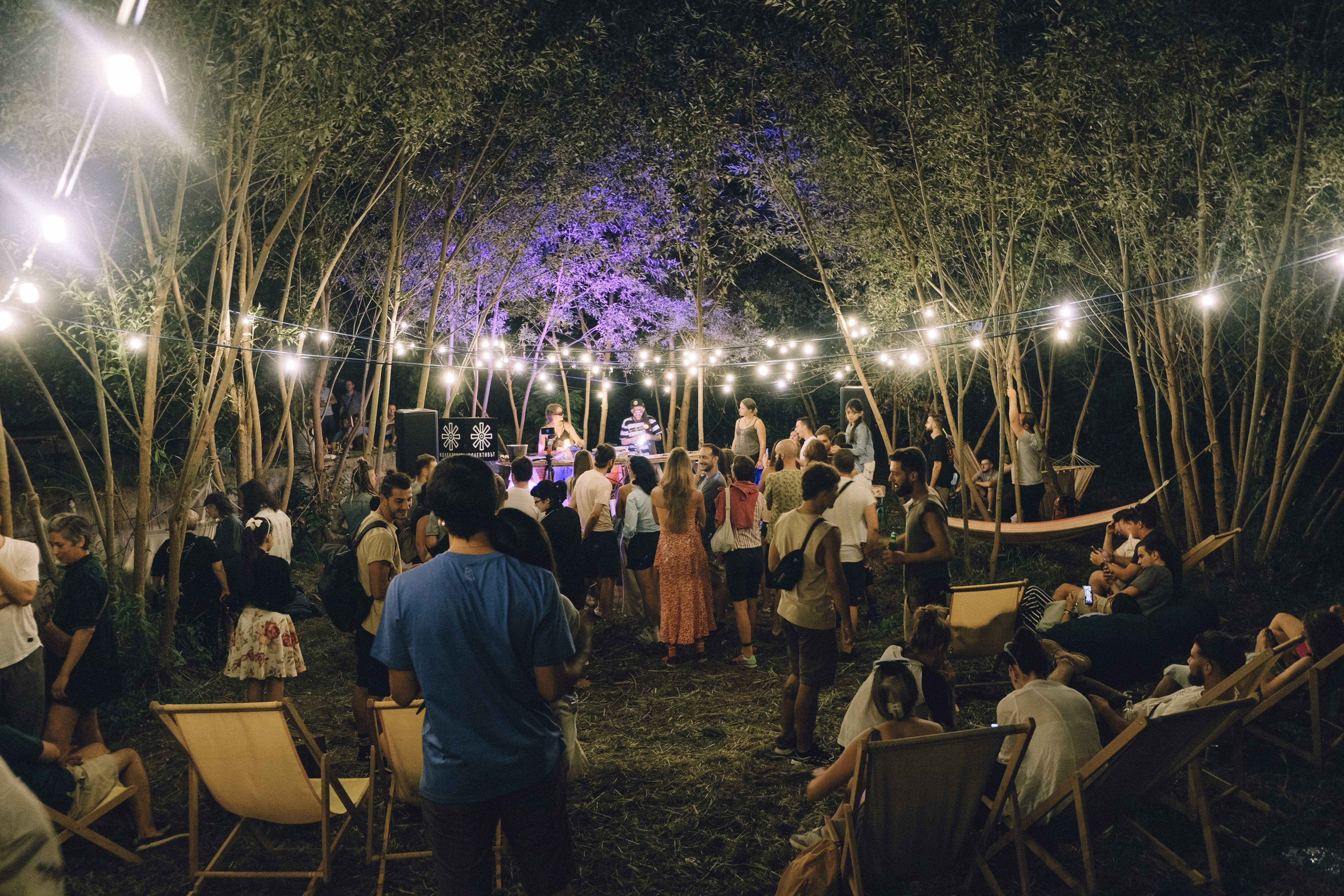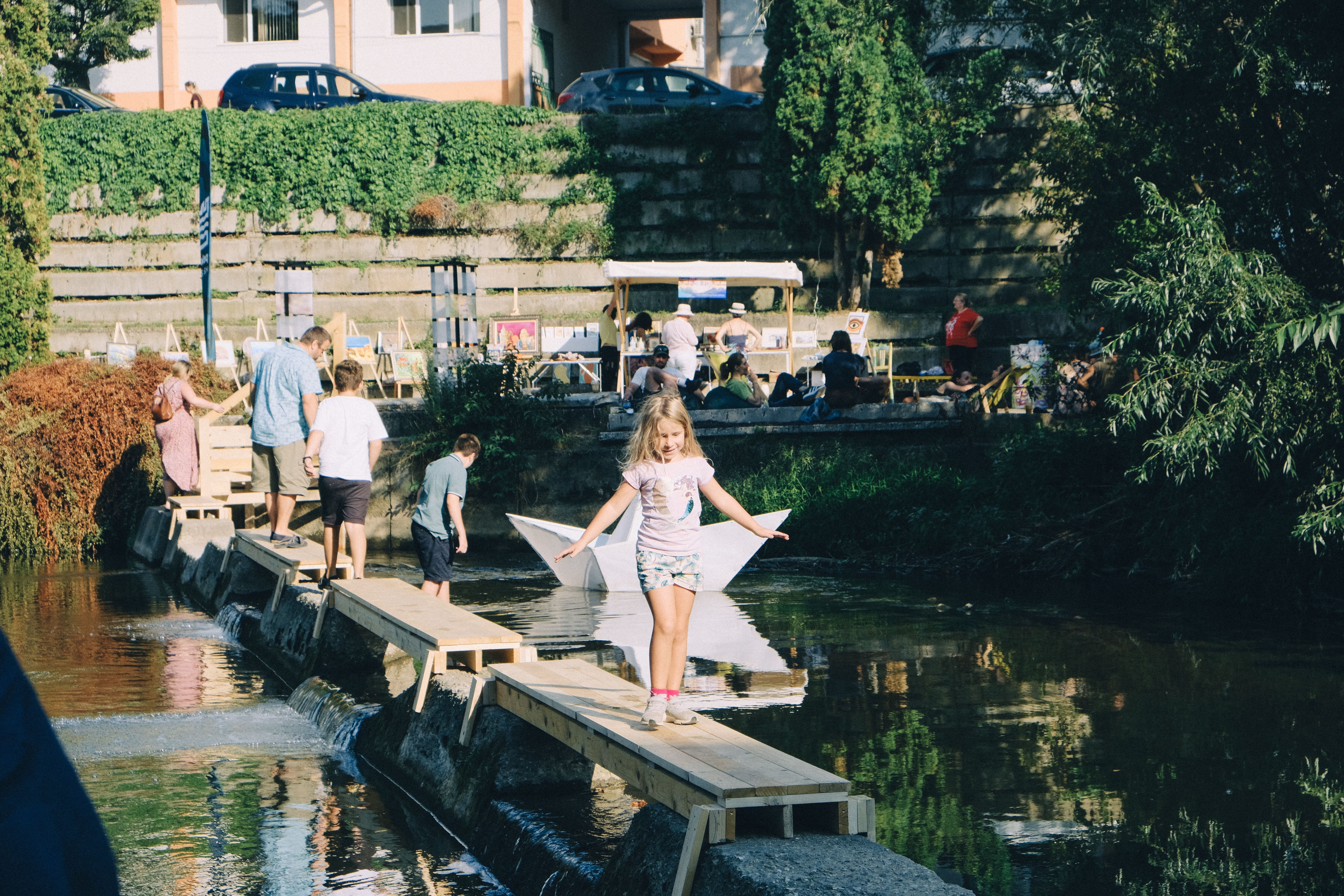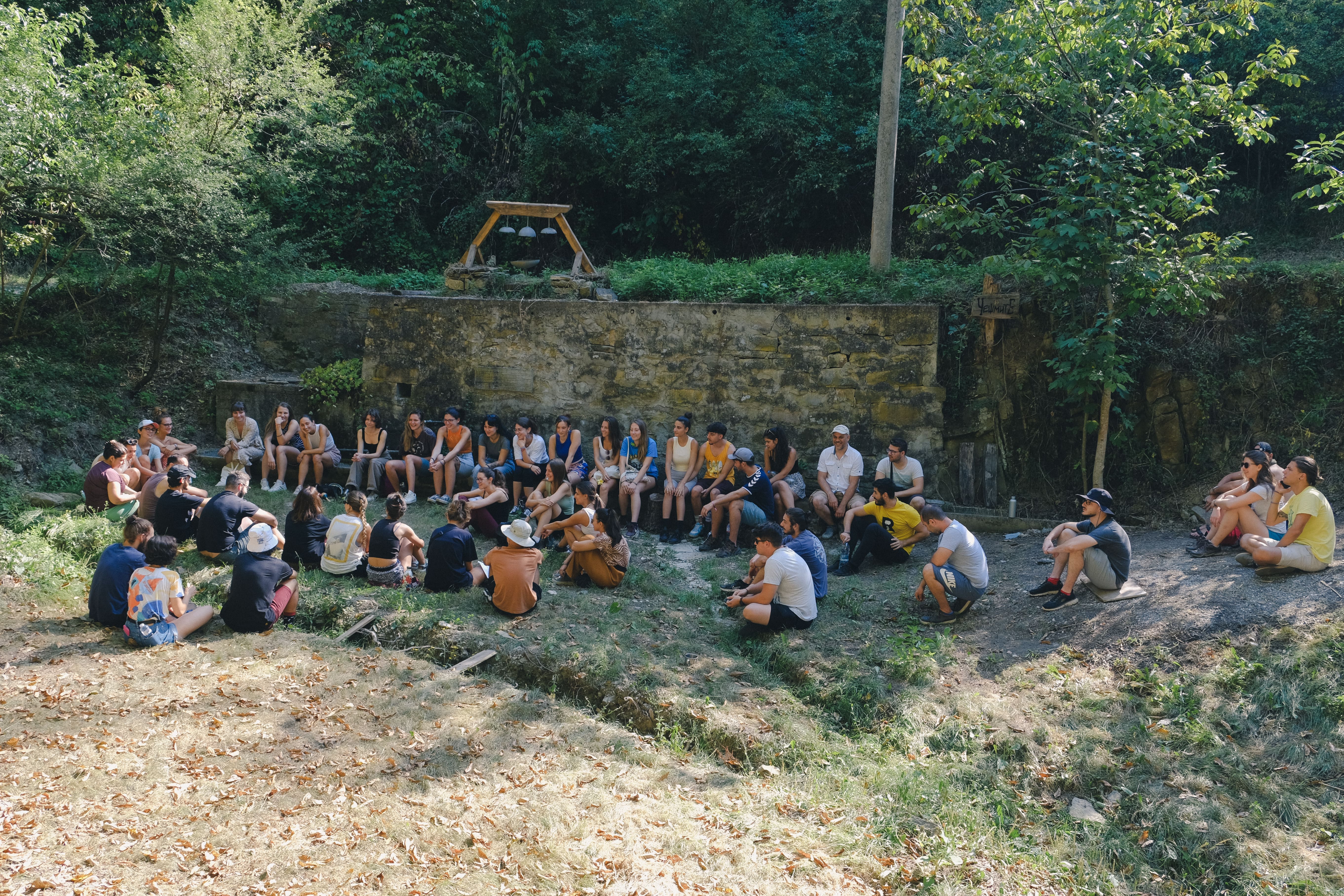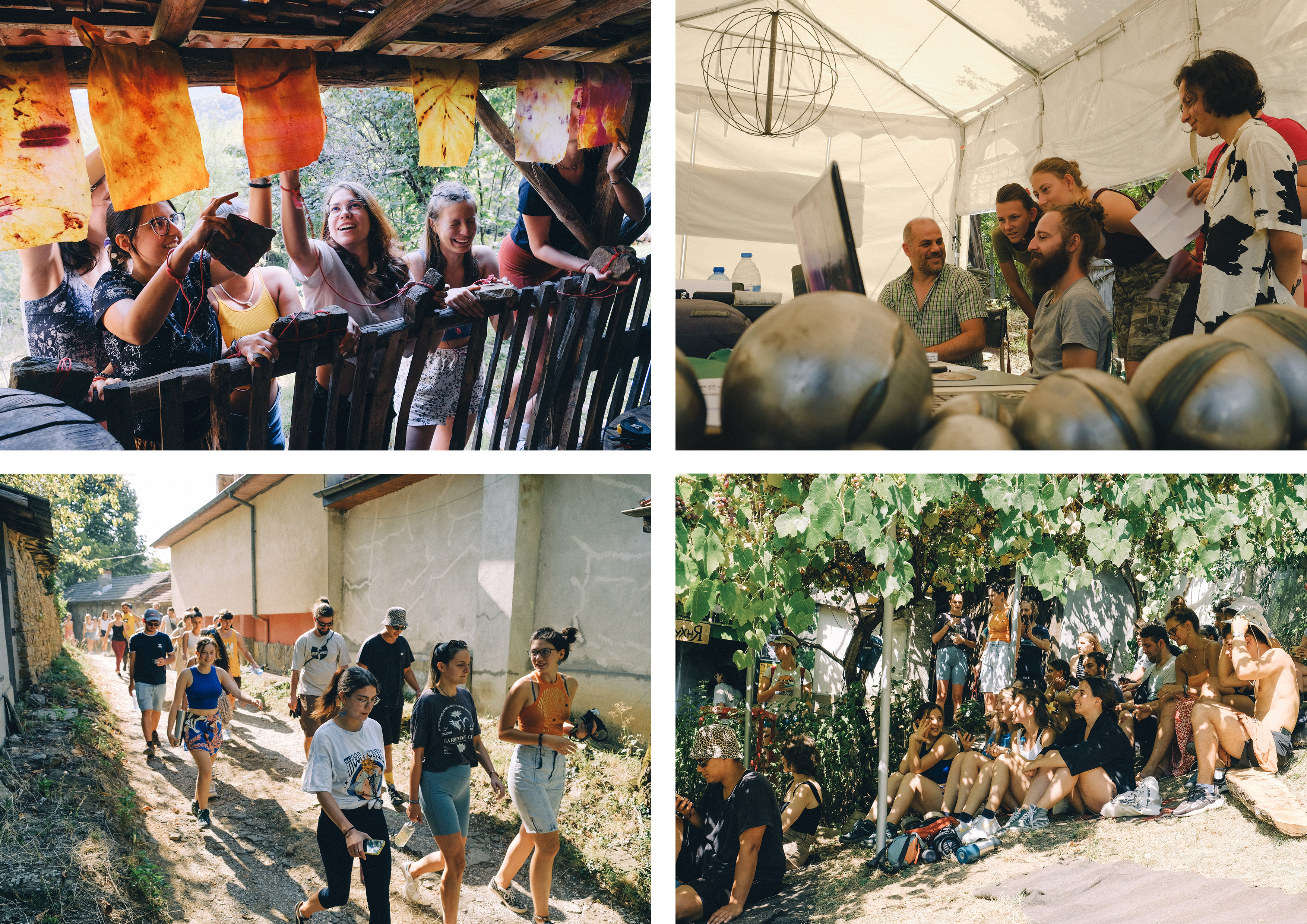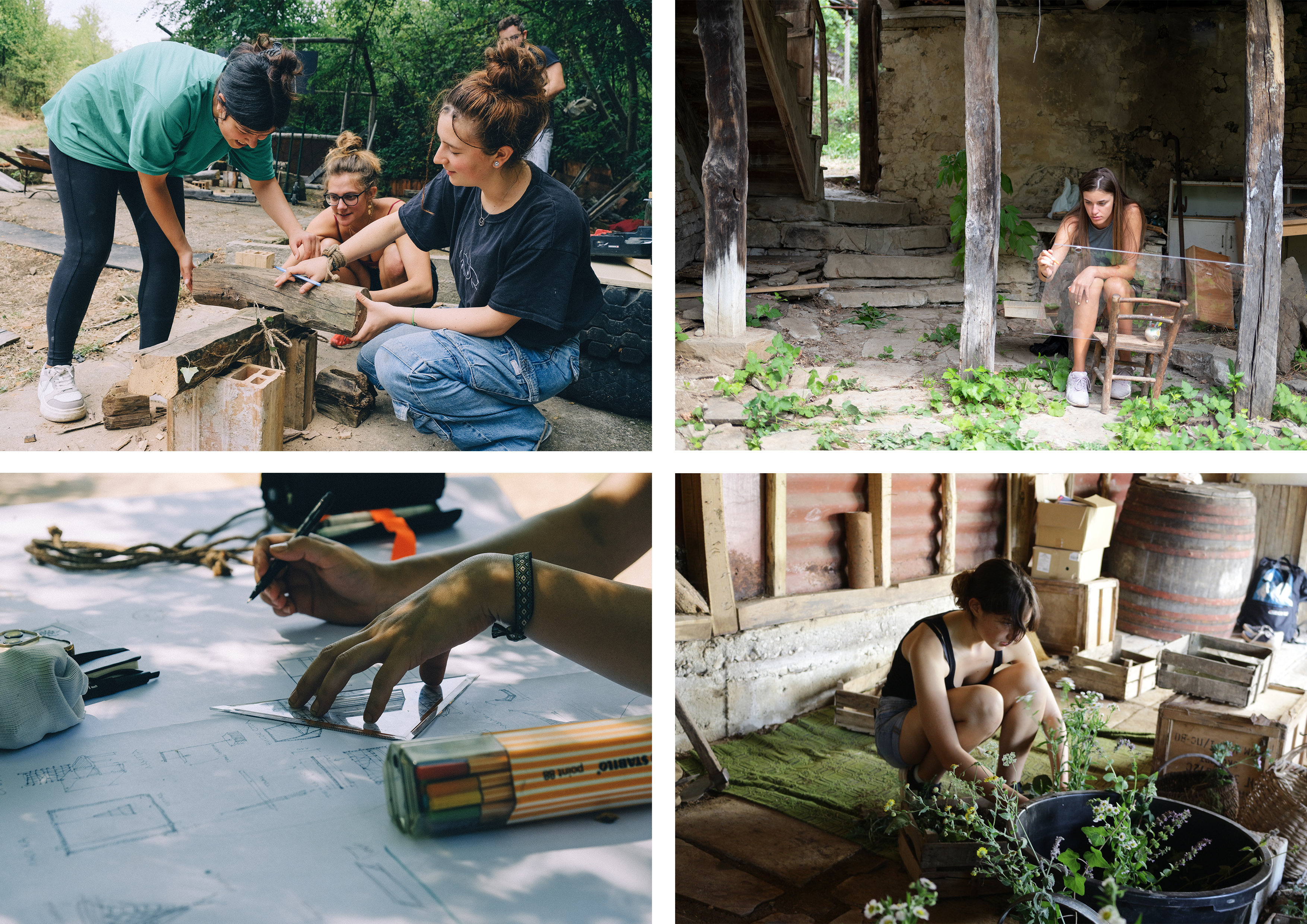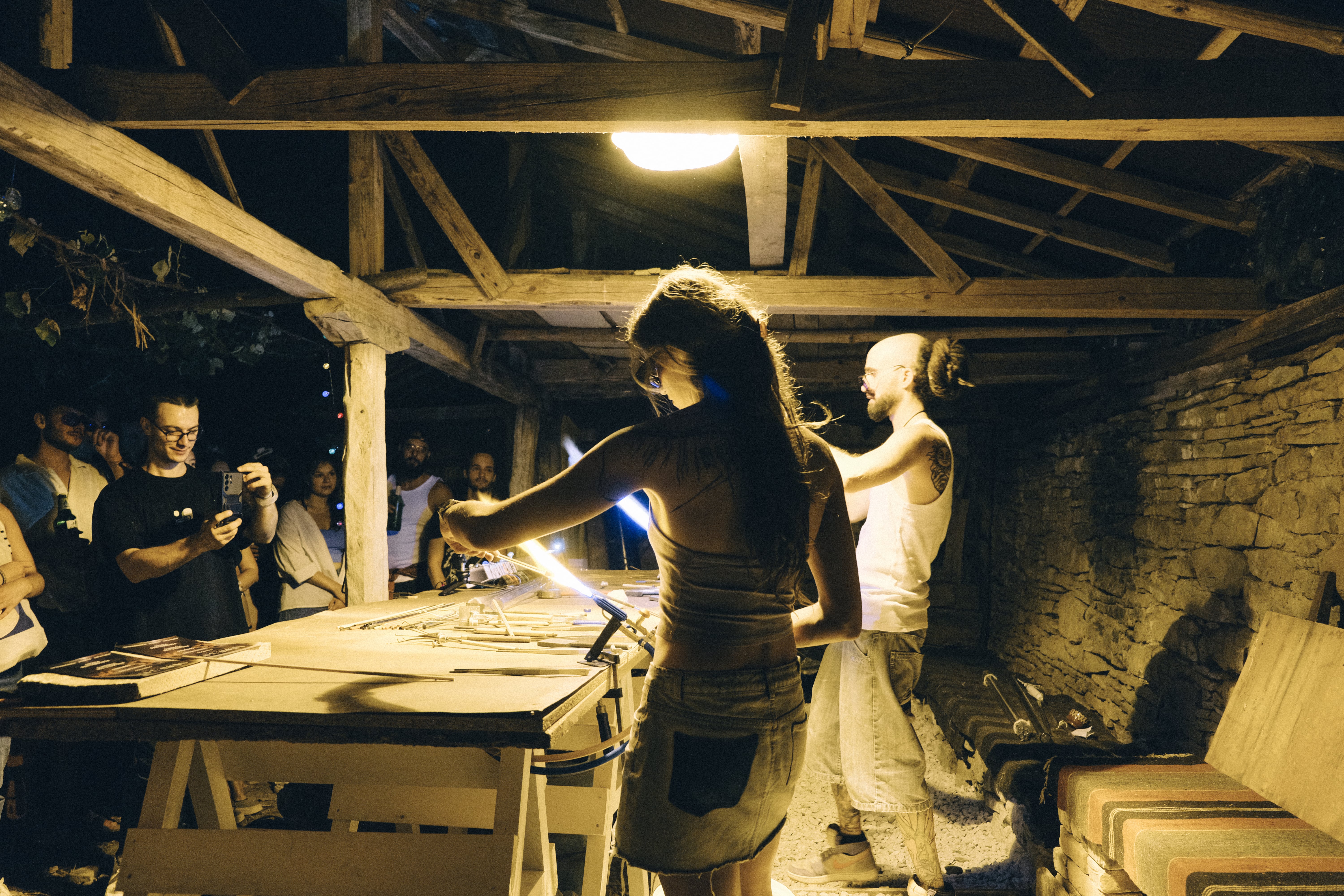Regaining a sense of belonging
UP/DOWN
UP/DOWN: Connecting rural and urban communities along the Osam River
UP/DOWN turns the Osam River into a thread linking rural and urban communities through art, heritage crafts, and communal placemaking. In a rural art residency, youth upcycle vernacular architecture and found materials. Their artworks transform neglected spaces in the village and in a town downstream. A river festival restores urban nature and unites communities, as the Osam River connects village and city. The project shows an effective way to activate and reconnect remote, depopulating places.
Bulgaria
Regional
Troyan region
It addresses urban-rural linkages
It refers to a physical transformation of the built environment (hard investment)
Yes
2024-08-25
No
No
No
As a representative of an organisation, in partnership with other organisations
One of Bulgaria's structural challenges is the depopulation of small towns and villages, and the lack of infrastructure connecting rural and urban areas. The initiative UP/DOWN addresses this issue by launching a creative residency in the small village of Belish in the Balkan Mountains. Artworks created at the residency transform spaces in the village and downstream on the Osam River. Through the fusion of art, traditional crafts, and placemaking, the initiative bridges the generational gap and fosters connections between city and village life.
At the heart of the initiative is Belish Residence (UP), where young participants engage with deserted rural spaces and the elderly residents through a series of workshops. Using traditional crafts – ceramics, quilting, vernacular architecture – participants create site-specific art installations, which later transform neglected spaces on the Osam River in the nearby town of Troyan. The workshops allow for a mutual exchange of knowledge and skills, sparking innovation while honouring cultural heritage. In Troyan (DOWN), the initiative includes extensive cleaning efforts to restore the riverside area by local volunteers. Through placemaking, this area then becomes an active site for the UP/DOWN community to come together.
The shared space is brought to life through cultural programming featuring local musicians, artists, and craftspeople during a 3-day festival. The river becomes a physical thread linking traditions, communities, and shared futures.
The whole project is run by a focus group uniting youth from Troyan and other cities, along with architecture students. With mentorship and support from experienced professionals from Belish Residence and The Collective, these young activists organise the workshops, recruit and engage participants and volunteers, and organise the community festival. This approach of foregrounding young voices ensures more grassroots involvement and participation.
At the heart of the initiative is Belish Residence (UP), where young participants engage with deserted rural spaces and the elderly residents through a series of workshops. Using traditional crafts – ceramics, quilting, vernacular architecture – participants create site-specific art installations, which later transform neglected spaces on the Osam River in the nearby town of Troyan. The workshops allow for a mutual exchange of knowledge and skills, sparking innovation while honouring cultural heritage. In Troyan (DOWN), the initiative includes extensive cleaning efforts to restore the riverside area by local volunteers. Through placemaking, this area then becomes an active site for the UP/DOWN community to come together.
The shared space is brought to life through cultural programming featuring local musicians, artists, and craftspeople during a 3-day festival. The river becomes a physical thread linking traditions, communities, and shared futures.
The whole project is run by a focus group uniting youth from Troyan and other cities, along with architecture students. With mentorship and support from experienced professionals from Belish Residence and The Collective, these young activists organise the workshops, recruit and engage participants and volunteers, and organise the community festival. This approach of foregrounding young voices ensures more grassroots involvement and participation.
Community
Heritage
Sustainability
Crafts
Revitalisation
The project re-values neglected spaces, materials, and even traditions, infusing them with new life and adapting them to meet contemporary needs.
One significant accomplishment of UP/DOWN was the revival of a neglected river park near Troyan's city center, located on the Osam River. Constructed during the socialist era and abandoned for over 2 decades, the park had become overrun by nature and invasive species, rendering it inaccessible. Through 4 collaborative clean-up actions with local volunteers, we restored access to the park by carefully managing the overgrowth—specifically targeting invasive species like willows while preserving the natural biodiversity. This effort unveiled hidden architectural features such as staircases, ramps, and terraces, effectively bringing this community space back to life.
The place was reinvigorated and opened to the public, enriched with art installations and cultural events. All interventions and workshops in Belish utilised recycled and sustainable materials. Structures were crafted from reclaimed materials like timber and traditional stone roofing sheets from demolished houses. Additionally, natural dyes made from herbs and flowers were used to repurpose old fabrics, emphasising sustainability in every aspect of the project.
During their week at Belish Residence, around 80 participants, organisers, and workshop tutors from various regions of Bulgaria stayed together in the village, setting up camp in abandoned houses and yards. They followed specific guidelines to conserve water, recycle waste, and cook communally, effectively minimising their environmental footprint.
This re-valuing of places, ecosystems and traditions is sustainable in a deep sense, as it engages existing resources to rebuild community, setting up an Up/Down circular creative process. The project can be an example for other remote and depopulating areas of how to use crafts and placemaking in a socially and culturally restorative and sustainable way.
One significant accomplishment of UP/DOWN was the revival of a neglected river park near Troyan's city center, located on the Osam River. Constructed during the socialist era and abandoned for over 2 decades, the park had become overrun by nature and invasive species, rendering it inaccessible. Through 4 collaborative clean-up actions with local volunteers, we restored access to the park by carefully managing the overgrowth—specifically targeting invasive species like willows while preserving the natural biodiversity. This effort unveiled hidden architectural features such as staircases, ramps, and terraces, effectively bringing this community space back to life.
The place was reinvigorated and opened to the public, enriched with art installations and cultural events. All interventions and workshops in Belish utilised recycled and sustainable materials. Structures were crafted from reclaimed materials like timber and traditional stone roofing sheets from demolished houses. Additionally, natural dyes made from herbs and flowers were used to repurpose old fabrics, emphasising sustainability in every aspect of the project.
During their week at Belish Residence, around 80 participants, organisers, and workshop tutors from various regions of Bulgaria stayed together in the village, setting up camp in abandoned houses and yards. They followed specific guidelines to conserve water, recycle waste, and cook communally, effectively minimising their environmental footprint.
This re-valuing of places, ecosystems and traditions is sustainable in a deep sense, as it engages existing resources to rebuild community, setting up an Up/Down circular creative process. The project can be an example for other remote and depopulating areas of how to use crafts and placemaking in a socially and culturally restorative and sustainable way.
At Belish Residence, 5 workshops led by artists and architects were held that blended tradition, art, and sustainability. Through hands-on learning, the students participating in those workshops created artworks that enriched local cultural and social life. Each group produced site-specific works that contributed to communities in Belish (Up) and Troyan (Down).
The Memory Threads workshop celebrated traditional crafts by repurposing materials from abandoned Belish houses into functional urban furniture. Participants worked with reclaimed wood and rope, creating installations that enhanced public spaces by honouring heritage.
In the Agora 24 workshop, participants crafted a circular textile canopy from recycled fabrics. The canopy created a welcoming space for community near the river in Troyan.
The Zherda workshop used natural dyes, reclaimed fabric, and wooden beams to create art installations that linked different parts of the river.
In the Musicalia workshop, participants transformed everyday objects into musical instruments, culminating in a lively jam session with local residents.
"Planation" engaged with celestial scales, positioning solar system models across Troyan to blend scientific wonder with community interaction. This workshop enhanced local engagement and spatial awareness of the broader region along the river.
The 3-day festival was the highlight of the week at Belish, featuring art installations from the workshops displayed along the Osam River. The area was transformed with artistic lighting, a temporary stage, and comfortable seating, creating a welcoming atmosphere. The revitalised riverside was further enhanced by a rich cultural programme that included local musicians and performance artists. The project is exemplary in its activation of local materials, tradition, nature, and talent to create an immersive experience that unites communities and revitalises shared spaces.
The Memory Threads workshop celebrated traditional crafts by repurposing materials from abandoned Belish houses into functional urban furniture. Participants worked with reclaimed wood and rope, creating installations that enhanced public spaces by honouring heritage.
In the Agora 24 workshop, participants crafted a circular textile canopy from recycled fabrics. The canopy created a welcoming space for community near the river in Troyan.
The Zherda workshop used natural dyes, reclaimed fabric, and wooden beams to create art installations that linked different parts of the river.
In the Musicalia workshop, participants transformed everyday objects into musical instruments, culminating in a lively jam session with local residents.
"Planation" engaged with celestial scales, positioning solar system models across Troyan to blend scientific wonder with community interaction. This workshop enhanced local engagement and spatial awareness of the broader region along the river.
The 3-day festival was the highlight of the week at Belish, featuring art installations from the workshops displayed along the Osam River. The area was transformed with artistic lighting, a temporary stage, and comfortable seating, creating a welcoming atmosphere. The revitalised riverside was further enhanced by a rich cultural programme that included local musicians and performance artists. The project is exemplary in its activation of local materials, tradition, nature, and talent to create an immersive experience that unites communities and revitalises shared spaces.
The UP/DOWN initiative places youth in a leading role, empowering them to shape and implement all activities while receiving mentorship from experienced professionals. Our theory of change is that youth can lead the process of reconnecting the generations and revitalising neglected spaces in depopulating communities.
At Belish Residence, all participants, organisers and workshop tutors—around 80 people from various regions of Bulgaria—lived together in the village. To accommodate this large group, new functional zones were created throughout Belish. Abandoned public spaces were repurposed into a lively community hub, including a camping area, a community kitchen, a bar, public showers, gathering spaces, and workshop areas. These transformations brought life back to the semi-abandoned village and fostered new connections, showcasing the potential for revitalisation and collaboration within the local community.
All workshops promoted engagement and co-creation between young attendees and the village's elderly residents. Similarly, the festival programme was designed to be open and accessible to everyone. All events were free and celebrated local talents, which the youth group leading the initiative identified during community mapping sessions. The varied festival lineup included musical performances and traditional craft workshops like clay sculpting, calligraphy, and woodworking. It was tailored to appeal to different age groups.
The festival culminated in an open-doors event at Belish Residence, where organised transportation allowed visitors from the city to explore the revitalised spaces of the village. This event provided a firsthand look at the creative outcomes from the workshops and the collaborative spirit that fueled the festival, fostering a deeper connection between urban and rural communities. The project is exemplary for involving different communities across the urban-rural divide in a shared initiative for creative renewal.
At Belish Residence, all participants, organisers and workshop tutors—around 80 people from various regions of Bulgaria—lived together in the village. To accommodate this large group, new functional zones were created throughout Belish. Abandoned public spaces were repurposed into a lively community hub, including a camping area, a community kitchen, a bar, public showers, gathering spaces, and workshop areas. These transformations brought life back to the semi-abandoned village and fostered new connections, showcasing the potential for revitalisation and collaboration within the local community.
All workshops promoted engagement and co-creation between young attendees and the village's elderly residents. Similarly, the festival programme was designed to be open and accessible to everyone. All events were free and celebrated local talents, which the youth group leading the initiative identified during community mapping sessions. The varied festival lineup included musical performances and traditional craft workshops like clay sculpting, calligraphy, and woodworking. It was tailored to appeal to different age groups.
The festival culminated in an open-doors event at Belish Residence, where organised transportation allowed visitors from the city to explore the revitalised spaces of the village. This event provided a firsthand look at the creative outcomes from the workshops and the collaborative spirit that fueled the festival, fostering a deeper connection between urban and rural communities. The project is exemplary for involving different communities across the urban-rural divide in a shared initiative for creative renewal.
UP/DOWN is built on a participatory model that involves citizens, local communities, and civil society at every stage.Тhe project fosters co-creation and shared responsibility for public spaces, ensuring a high level of citizen engagement.
One of the ways citizens have been involved is through community cleanups and revitalisation efforts along the Osam River in Troyan. Initially, a small group of young volunteers started the cleanup process, but as their work became visible, local residents—including families, students, elderly citizens joined in. By the final cleanup, over 30 volunteers were actively shaping the transformation of the neglected riverside area.
At Belish Residence, elderly residents played a crucial role in knowledge exchange. Through workshops on traditional crafts, architecture, and storytelling, they shared their expertise with young participants, creating a meaningful intergenerational dialogue. This process not only preserved cultural heritage but also empowered older residents to take an active role in shaping the future of their village.
The project also engaged local government and civil society. Troyan Municipality and local businesses contributed tools, materials, and logistical support, while other institutions, such as the Troyan Info Center, helped coordinate festival activities. This collaboration strengthened the project's sustainability and reach.
The Rivers of the City Troyan Festival further deepened community involvement by providing a platform for local artists, musicians, and craftspeople to showcase their work. The festival’s open format invited active participation, making the revitalised riverside a shared cultural space shaped by and for the local community.
Through this model of engagement, UP/DOWN demonstrates how citizen participation can lead to lasting change, stronger social bonds, and a renewed sense of belonging, making it an exemplary project in the context of the New European Bauhaus principles.
One of the ways citizens have been involved is through community cleanups and revitalisation efforts along the Osam River in Troyan. Initially, a small group of young volunteers started the cleanup process, but as their work became visible, local residents—including families, students, elderly citizens joined in. By the final cleanup, over 30 volunteers were actively shaping the transformation of the neglected riverside area.
At Belish Residence, elderly residents played a crucial role in knowledge exchange. Through workshops on traditional crafts, architecture, and storytelling, they shared their expertise with young participants, creating a meaningful intergenerational dialogue. This process not only preserved cultural heritage but also empowered older residents to take an active role in shaping the future of their village.
The project also engaged local government and civil society. Troyan Municipality and local businesses contributed tools, materials, and logistical support, while other institutions, such as the Troyan Info Center, helped coordinate festival activities. This collaboration strengthened the project's sustainability and reach.
The Rivers of the City Troyan Festival further deepened community involvement by providing a platform for local artists, musicians, and craftspeople to showcase their work. The festival’s open format invited active participation, making the revitalised riverside a shared cultural space shaped by and for the local community.
Through this model of engagement, UP/DOWN demonstrates how citizen participation can lead to lasting change, stronger social bonds, and a renewed sense of belonging, making it an exemplary project in the context of the New European Bauhaus principles.
The success of the UP/DOWN initiative lies in its network of engaged stakeholders at the local, regional, and national levels.
At the local level, the most significant partners were the citizens of Belish and Troyan, as well as the municipality of Troyan. The active participation of local residents ensured that the project was rooted in the community’s needs, while it also attracted the municipality’s support. Troyan Municipality assisted with logistics and material resources, including facilitating the use of public spaces and engaging with local businesses to contribute to the initiative.
At the regional level, the project benefited from collaborations with relevant institutions, such as the Troyan Info Center, which helped spread awareness of the festival and facilitated communication between various local actors. Belish Residence played a central role by offering a space for creative residency and fostering dialogue between urban youth and elderly villagers.
At the national level, collaboration with The Collective Foundation ensured that the project was aligned with larger goals for sustainable urban development. They provided expertise in the design of temporary architectural interventions, as well as communications, which helped strengthen the project’s relevance across Bulgaria. The open calls for participation brought together young people from across the country, creating a network of engaged citizens working toward shared objectives of urban-rural connection and sustainable design.
Through these engagements, UP/DOWN brought together multi-level stakeholders whose added value ranged from deeply rooted local knowledge to international best practices, creating a project that resonates across various scales and serves as a model for integrated urban-rural revitalisation.
At the local level, the most significant partners were the citizens of Belish and Troyan, as well as the municipality of Troyan. The active participation of local residents ensured that the project was rooted in the community’s needs, while it also attracted the municipality’s support. Troyan Municipality assisted with logistics and material resources, including facilitating the use of public spaces and engaging with local businesses to contribute to the initiative.
At the regional level, the project benefited from collaborations with relevant institutions, such as the Troyan Info Center, which helped spread awareness of the festival and facilitated communication between various local actors. Belish Residence played a central role by offering a space for creative residency and fostering dialogue between urban youth and elderly villagers.
At the national level, collaboration with The Collective Foundation ensured that the project was aligned with larger goals for sustainable urban development. They provided expertise in the design of temporary architectural interventions, as well as communications, which helped strengthen the project’s relevance across Bulgaria. The open calls for participation brought together young people from across the country, creating a network of engaged citizens working toward shared objectives of urban-rural connection and sustainable design.
Through these engagements, UP/DOWN brought together multi-level stakeholders whose added value ranged from deeply rooted local knowledge to international best practices, creating a project that resonates across various scales and serves as a model for integrated urban-rural revitalisation.
In UP/DOWN, аrchitecture, art, craft, sustainability, and community building intersect in a holistic approach to urban-rural revitalisation.
At the core of the project are architecture, craft, and art. The revitalisation of neglected spaces integrated traditional crafts with a contemporary placemaking approach. Local woodworkers, ceramic artists, and textile workers collaborated with young workshop participants to blend cultural heritage with newer design ideas to create functional art installations that restored shared spaces. This interdisciplinary approach fostered an exchange of skills and knowledge—young participants learned traditional techniques from the elderly, while artisans and locals were introduced to contemporary sustainable urban design.
In addition to art and architecture, environmental sustainability played a crucial role. Environmental advocates contributed to preserving the natural environment of the Osam River while engaging the community in clean-up efforts. Sustainable design principles ensured that the revitalisation of public spaces was both ecologically sensitive and community-driven, reducing waste and promoting the reuse of local materials.
Cultural managers and community organisers experienced in placemaking methods added their expertise, ensuring that the project was not only about physical revitalisation but also social empowerment, creating spaces for intergenerational dialogue and strengthening social cohesion. Experienced civic engagement professionals mentored youth, who were empowered to lead the project in order to strengthen its grassroots base.
UP/DOWN unites traditional crafts with collective placemaking and community-driven environmental activism. This way, the project re-values and restores local traditions and nature and achieves regional transformation through art and crafts. This blend of disciplines makes up an innovative approach to revitalising depopulating areas, whose effectiveness was proven in practice.
At the core of the project are architecture, craft, and art. The revitalisation of neglected spaces integrated traditional crafts with a contemporary placemaking approach. Local woodworkers, ceramic artists, and textile workers collaborated with young workshop participants to blend cultural heritage with newer design ideas to create functional art installations that restored shared spaces. This interdisciplinary approach fostered an exchange of skills and knowledge—young participants learned traditional techniques from the elderly, while artisans and locals were introduced to contemporary sustainable urban design.
In addition to art and architecture, environmental sustainability played a crucial role. Environmental advocates contributed to preserving the natural environment of the Osam River while engaging the community in clean-up efforts. Sustainable design principles ensured that the revitalisation of public spaces was both ecologically sensitive and community-driven, reducing waste and promoting the reuse of local materials.
Cultural managers and community organisers experienced in placemaking methods added their expertise, ensuring that the project was not only about physical revitalisation but also social empowerment, creating spaces for intergenerational dialogue and strengthening social cohesion. Experienced civic engagement professionals mentored youth, who were empowered to lead the project in order to strengthen its grassroots base.
UP/DOWN unites traditional crafts with collective placemaking and community-driven environmental activism. This way, the project re-values and restores local traditions and nature and achieves regional transformation through art and crafts. This blend of disciplines makes up an innovative approach to revitalising depopulating areas, whose effectiveness was proven in practice.
The UP/DOWN initiative introduces a novel approach to the revitalisation of rural and urban spaces by combining art, craft and environmental preservation.It is structured in several stages: community craft workshops, cleanups and a festival with community involvement at each stage.This method maximises the impact of typical art residencies by engaging crafts, tradition and diverse communities to influence local development across the rural-urban divide.One of the key innovations is the intergenerational dialogue through collaborative workshops, where traditional crafts (such as ceramics, woodworking, etc) meet contemporary architectural and design practices.This interdisciplinary approach creates a space for cultural exchange. UP/DOWN emphasises the co-creation process.The initiative is youth-led and local communities play an active role in shaping their environment.The workshops encourage mutual learning, blending local knowledge with modern techniques.This hands-on, participatory approach to urban renewal allows for the creation of meaningful public spaces rooted in local identity and needs. Crafts and placemaking are not usually practiced together but can make for a powerful new approach to revitalising communities, especially in remote and rural areas. The integration of ecological sustainability is another innovative aspect.The project revives neglected spaces in an environmentally conscious way—through clean-up initiatives, use of local materials in a circular way, and creating installations with a light environmental footprint. Finally, the cultural programming at the festival, with its focus on local heritage and multidisciplinary collaboration, positions UP/DOWN as a model that moves beyond beautifying public spaces and enhances social cohesion. UP/DOWN provides a comprehensive model that effectively unites crafts, site-specific art, placemaking, ecological preservation, and community empowerment in a new and effective way.
At its core, the project follows a co-creation model, where local communities, young people, and artists work together to design and implement interventions that reflect both the cultural heritage and contemporary needs of the area. The first step of the methodology involved community mapping and research to understand the historical, social, and environmental context of the village of Belish and the town of Troyan. This ensured that the project was grounded in the realities of the local context, and addressed the needs of the community.
The project methodology is interdisciplinary, integrating art, architecture, design, and environmental activism. Workshops conducted in Belish brought together professionals from different fields—architectural students, local artisans, young creatives, and community members—to exchange knowledge and co-create interventions. This interaction between traditional craftsmanship and modern design allowed participants to draw upon the region’s cultural identity while addressing contemporary issues such as depopulation, environmental neglect, and the need for public spaces that encourage community interaction.
Through a series of hands-on workshops and site-specific installations, participants were actively involved in the design and transformation of underutilised public spaces in both Belish and Troyan. The methodology emphasises co-creation and learning by doing, where the act of creating art, architecture, and public spaces becomes an essential part of the community-building and revitalisation process.
Additionally, the project’s approach was inclusive and bottom-up, prioritising the participation of local residents and volunteers in the workshops, cleaning initiatives, placemaking, and festival performances. These activities not only fostered community spirit but also helped to build a sense of ownership and pride in the shared spaces.
The project methodology is interdisciplinary, integrating art, architecture, design, and environmental activism. Workshops conducted in Belish brought together professionals from different fields—architectural students, local artisans, young creatives, and community members—to exchange knowledge and co-create interventions. This interaction between traditional craftsmanship and modern design allowed participants to draw upon the region’s cultural identity while addressing contemporary issues such as depopulation, environmental neglect, and the need for public spaces that encourage community interaction.
Through a series of hands-on workshops and site-specific installations, participants were actively involved in the design and transformation of underutilised public spaces in both Belish and Troyan. The methodology emphasises co-creation and learning by doing, where the act of creating art, architecture, and public spaces becomes an essential part of the community-building and revitalisation process.
Additionally, the project’s approach was inclusive and bottom-up, prioritising the participation of local residents and volunteers in the workshops, cleaning initiatives, placemaking, and festival performances. These activities not only fostered community spirit but also helped to build a sense of ownership and pride in the shared spaces.
The project’s activation of local craft traditions and heritage for broader impact on regional connection and revitalisation can be applied in other areas facing challenges such as depopulation and lack of civic infrastructure. It would be particularly relevant in areas struggling with a disconnect between rural and urban communities.
The project's focus on community-led revitalisation of neglected public spaces can be employed by other communities looking to rejuvenate underused areas. The model of leadership by a youth focus group can also increase grassroots involvement in other contexts and encourage a sense of ownership and belonging.
The workshop model, which brings together a diverse range of participants from different disciplines, along with local residents, can be replicated to foster cross-sectoral collaboration. This approach facilitates the exchange of knowledge and skills across generations and professions, offering a template for integrating education, creativity, and community action.
The project’s emphasis on eco-friendly design and the reuse of materials—such as reclaimed wood and traditional construction methods—provides a sustainable model for similar efforts in other areas. The integration of green infrastructure is particularly relevant to regions aiming to address environmental sustainability while enhancing their cultural heritage.
The Rivers of the City Troyan Festival offers a replicable framework for organising inclusive public events that celebrate local culture and foster community even on a small budget. Such festivals can be adapted to suit various contexts, bringing together different generations and communities in an inclusive celebration of shared spaces.
The mentorship model used to build skills and confidence in youth can be applied in other regions to nurture a new generation of change-makers capable of tackling local or regional challenges.
The project's focus on community-led revitalisation of neglected public spaces can be employed by other communities looking to rejuvenate underused areas. The model of leadership by a youth focus group can also increase grassroots involvement in other contexts and encourage a sense of ownership and belonging.
The workshop model, which brings together a diverse range of participants from different disciplines, along with local residents, can be replicated to foster cross-sectoral collaboration. This approach facilitates the exchange of knowledge and skills across generations and professions, offering a template for integrating education, creativity, and community action.
The project’s emphasis on eco-friendly design and the reuse of materials—such as reclaimed wood and traditional construction methods—provides a sustainable model for similar efforts in other areas. The integration of green infrastructure is particularly relevant to regions aiming to address environmental sustainability while enhancing their cultural heritage.
The Rivers of the City Troyan Festival offers a replicable framework for organising inclusive public events that celebrate local culture and foster community even on a small budget. Such festivals can be adapted to suit various contexts, bringing together different generations and communities in an inclusive celebration of shared spaces.
The mentorship model used to build skills and confidence in youth can be applied in other regions to nurture a new generation of change-makers capable of tackling local or regional challenges.
The UP/DOWN project effectively addresses several global challenges by providing innovative, localised solutions. By focusing on community-driven revitalisation, sustainability, and cultural preservation, the project tackles critical issues that resonate both locally and globally.
Climate change and environmental sustainability: The project integrates sustainable design and eco-friendly practices, including the use of reclaimed materials, green infrastructure, and natural river revitalisation. The revitalised public spaces not only help to reduce carbon footprints but also provide green zones that improve biodiversity, fostering a healthier urban environment.
Depopulation and rural development: In areas facing depopulation the project offers a solution by rejuvenating public spaces and creating cultural hubs that attract both residents and visitors. This helps combat the loss of local populations and brings new energy into communities. By integrating youth empowerment and creative industries, the project offers pathways for local employment and economic growth, addressing the global issue of rural depopulation and contributing to economic resilience.
Cultural preservation and identity: With increasing globalisation, the unique cultural identities of local communities are often at risk of being lost. The project offers a solution by celebrating and preserving the local heritage through art, design, and collaboration. By revitalising neglected spaces and engaging in interdisciplinary cultural projects, the initiative helps safeguard traditional crafts and cultural knowledge.
Social inequality and inclusivity: The project actively works towards social inclusion by ensuring that all community members are engaged in the process. The workshops, public interventions and festivals are designed to foster social cohesion, intergenerational dialogue, and equal access to cultural resources.
Climate change and environmental sustainability: The project integrates sustainable design and eco-friendly practices, including the use of reclaimed materials, green infrastructure, and natural river revitalisation. The revitalised public spaces not only help to reduce carbon footprints but also provide green zones that improve biodiversity, fostering a healthier urban environment.
Depopulation and rural development: In areas facing depopulation the project offers a solution by rejuvenating public spaces and creating cultural hubs that attract both residents and visitors. This helps combat the loss of local populations and brings new energy into communities. By integrating youth empowerment and creative industries, the project offers pathways for local employment and economic growth, addressing the global issue of rural depopulation and contributing to economic resilience.
Cultural preservation and identity: With increasing globalisation, the unique cultural identities of local communities are often at risk of being lost. The project offers a solution by celebrating and preserving the local heritage through art, design, and collaboration. By revitalising neglected spaces and engaging in interdisciplinary cultural projects, the initiative helps safeguard traditional crafts and cultural knowledge.
Social inequality and inclusivity: The project actively works towards social inclusion by ensuring that all community members are engaged in the process. The workshops, public interventions and festivals are designed to foster social cohesion, intergenerational dialogue, and equal access to cultural resources.
The project began with forming a focus group of young people passionate about the cause of revitalising the region. The focus group attracted workshop participants for the Belish Residence and selected 50 participants. As all participants from this large group worked, lived, cooked and socialised together, abandoned public spaces were repurposed into a community hub, including a community kitchen, public showers, gathering spaces, and workshop areas. These transformations brought life back to the semi-abandoned village in collaboration with locals.
In Troyan, community members were also engaged in lasting transformation of common spaces. Over 30 volunteers participated in cleanup actions to restore abandoned riverside spaces. Their efforts targeted a neglected former river park near Troyan’s city center. Built during the socialist period, the area had been abandoned for over 20 years, overtaken by nature and invasive species, making it inaccessible. Via the community actions, access to the park was restored and existing staircases, ramps, and terraces made usable again.
An important outcome has been the strengthening of a local multi-level coalition involving volunteers, craftspeople, artists and performers, and the municipality, who all contributed to revitalisation efforts, the workshops, and the community festival. The collaboration that the project established provides the basis for further renewal and community actions along the Osam River. These established connections and methods of co-creation mean that the initiative has the capacity to develop and grow after the first edition in 2024.
In conclusion, the project has had a visible impact on UP/DOWN communities in Belish and Troyan and has created lasting improvements to the local lived environment. It has set a new model for reconnecting communities in remote and rural regions and advancing sustainable development by leveraging local nature, art, and craft traditions.
In Troyan, community members were also engaged in lasting transformation of common spaces. Over 30 volunteers participated in cleanup actions to restore abandoned riverside spaces. Their efforts targeted a neglected former river park near Troyan’s city center. Built during the socialist period, the area had been abandoned for over 20 years, overtaken by nature and invasive species, making it inaccessible. Via the community actions, access to the park was restored and existing staircases, ramps, and terraces made usable again.
An important outcome has been the strengthening of a local multi-level coalition involving volunteers, craftspeople, artists and performers, and the municipality, who all contributed to revitalisation efforts, the workshops, and the community festival. The collaboration that the project established provides the basis for further renewal and community actions along the Osam River. These established connections and methods of co-creation mean that the initiative has the capacity to develop and grow after the first edition in 2024.
In conclusion, the project has had a visible impact on UP/DOWN communities in Belish and Troyan and has created lasting improvements to the local lived environment. It has set a new model for reconnecting communities in remote and rural regions and advancing sustainable development by leveraging local nature, art, and craft traditions.

